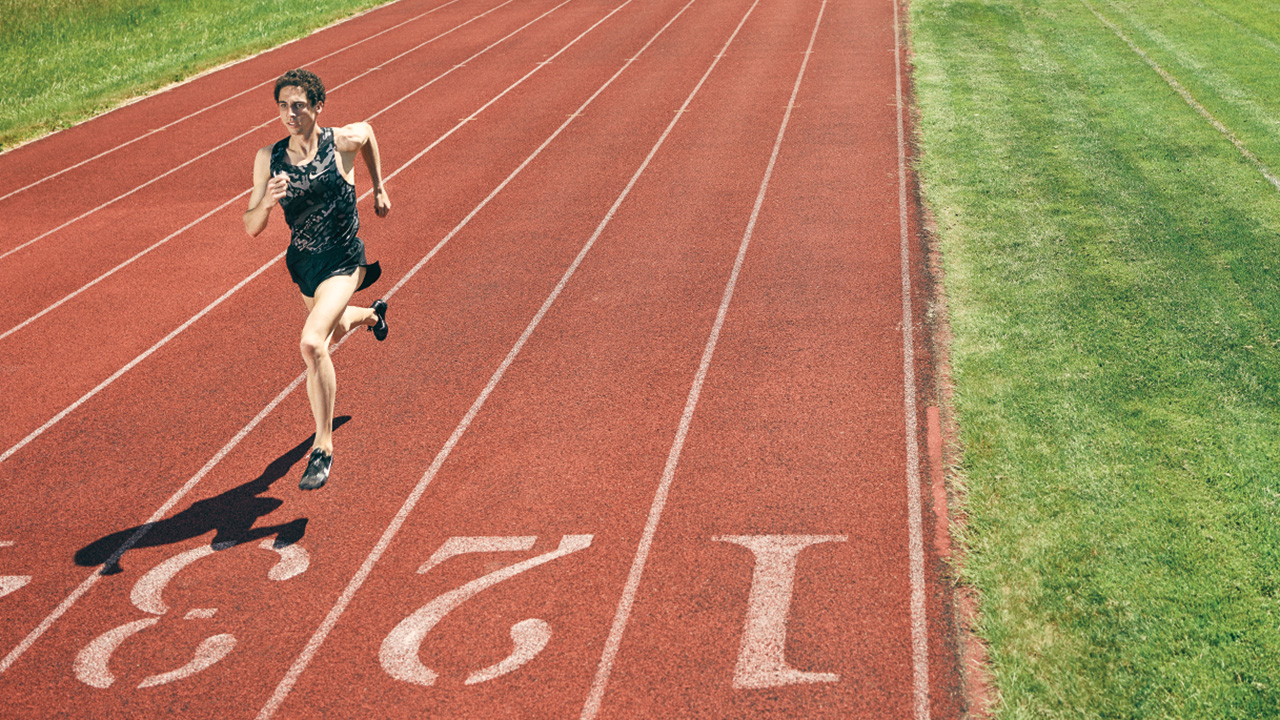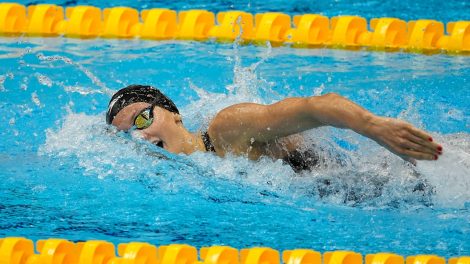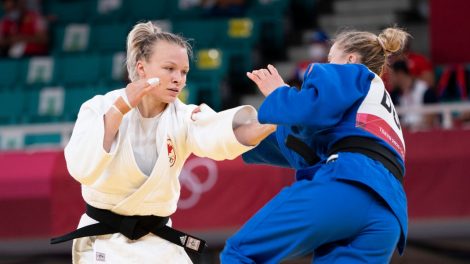One by one they fell, awash in lactic acid and defeat, chests heaving in search of oxygen they couldn’t find even in the thick night air of Eugene, Ore., some choosing to walk off the track for a DNF rather than stagger deep in Mo Farah’s wake. In the first 24 searing laps, the defending Olympic champion in the 5,000- and 10,000-metre had dropped 25 elite international runners, the last being two Kenyans, Paul Tanui and Geoffrey Kamworor, who chased him into the final straightaway. Born in Somalia but competing for Great Britain, Farah was using the Prefontaine Classic in May, the first meet of the IAAF Diamond League season, to take a shot at a personal best in the 10,000-metre, aiming for a time around 26:40. He fell about 10 seconds short of that, but still posted the year’s fastest time.
As Farah ran through the finish line, a late-breaking subplot emerged: Cameron Levins, who had been 90 metres off Farah’s pace at the halfway mark, was still in fourth place, not gaining ground but not losing any, either. The crowd in Eugene, a place where track and field really matters, recognized the 26-year-old from Vancouver Island and understood the significance of his run. They knew he had won the 5,000 and 10,000 double at the NCAAs as a senior at Southern Utah three years before. The announcer informed the crowd that Levins was on pace to break—no, shatter—the Canadian record. And when Levins crossed the line, his time was posted: 27:07.51, a personal best by 20 seconds. Off the tops of their heads, the fans might not have been able to tell you that this was the 151st-best 10,000-metre time ever, but they did know that it was the third-fastest time run by anyone born outside of East Africa.
At the Prefontaine last year, American Galen Rupp, the silver medallist behind Farah in London, ran 26:44.36, which turned out to be the fastest 10,000 of the year and the best ever run by someone from the non-African continents. To put African dominance of the event into perspective, Kenenisa Bekele of Ethiopia ran a 10-kilometre race in Brussels in 26:17.53 a decade ago, setting a world record that hasn’t been threatened since, 20 seconds clear of a field dominated by his countrymen and Kenyans. Thus, Levins is still a couple of breakthrough performances away from a world championship or an Olympic medal to add to the bronze he collected in the 10,000 at the Commonwealth Games last year, where he was passed at the line by, yes, a Ugandan and a Kenyan.
If you think it’s improbable that the East Africans will be left in Levins’s wake, understand that his career has been marked by one unforeseeable improvement after another. As a high schooler growing up in Black Creek, B.C., he never won a provincial title, never even finished second. Not a single major U.S. college expressed interest in him, and he landed a scholarship to little Southern Utah University only after posting his profile on a website, BeRecruited.com—he noticed that his profile had just one view, traced it back to SUU coach Eric Houle and contacted the athletic department.
At 19, the age at which Bekele was setting world records and Rupp was established as the boy wonder of U.S. running, Levins was trying and failing to make the NCAA nationals in the 1,500 as a sophomore. “He came home those first couple of years saying, ‘Those college guys are so good,'” his mother, Barb, says.
After the cross-country season in 2009, Levins made a decision that elevated his career at the risk of ending it or endangering his health. He bought into a plan laid out by coach Houle: a redshirt year out of competition, to be given over to three-a-day workouts and up to 190 miles a week, most at altitudes reaching 10,000 feet above sea level. It wasn’t that a more-is-better approach was unprecedented, just that it had fallen out of fashion. In the early ’70s, high-volume training was in vogue, with former 10-kilometre world record holder Dave Bedford of Britain running up to 240 miles a week. But Bedford set his record at age 23 and never won a major race after that, succumbing to injuries and seeing a sharp decline in performance. Bedford’s imitators likewise flamed out, most famously Alberto Salazar in the ’80s. The world’s top-ranked marathoner when he was 21, the Cuban-American Salazar put in 200-mile weeks with 20- and even 30-mile full-bore runs the day before races, competing through illness, even bronchitis. He was effectively done within three years. With Bedford and Salazar as cautionary tales, most coaches have placed a premium on quality and speed ever since.
Houle, however, had been experimenting with over-distance for his runners for years. By his reckoning, over-distance is productive training for a season or two but destructive in the long term. He also believes the problem wasn’t the stress on the runners’ bodies but rather the lack of recovery—that is, Bedford, Salazar and the other casualties weren’t overtrained so much as under-rested. “I told Cam that between runs, ‘If you see a bench, lie down and sleep on it, and if you see food on the ground, pick it up and eat it,'” he says. “You can’t know if a runner is going to tolerate the workload and you have to be ready to shut it down, permanently if necessary. Cam was able to do it.”
The risks weren’t limited to shin splints or tendinitis. As director of the Human Performance Laboratory at Appalachian State University, David Nieman studies athletes who suffer from overtraining syndrome (OTS). “The effects of OTS mimic chronic fatigue syndrome, [it can lead to] a long-term or permanent decline in performance,” says Nieman, who works with dozens of OTS sufferers. “The immune system can be compromised, leaving athletes at risk of infections. There can be long-term issues with cognitive function and memory. There’s no reason for a [college] runner to be running 190 miles a week. It’s not high-risk, high-reward. There’s no reward at all. There’s only risk.”
By the end of his redshirt season, Levins had developed adult-onset asthma, which he dismisses as “common” and “having something to do with running at altitude in cold weather.” His performances spiked immediately nonetheless. He ran a 27:27, brushing up against the Canadian 10,000 record, the first time he ever ran the race on the track. In meets, he’d run four distances: 800, 1,500, 5,000 and 10,000. It culminated in his senior year with his 5,000 and 10,000 double at the NCAA nationals in 2012. That summer, after graduating with a degree in exercise science, Levins made the finals in both events at the London Olympics.
After training with the SUU team for a stretch while his wife finished up school, Levins eventually landed in Beaverton, Ore., to train with Nike’s Oregon Project, the international team of distance runners who work under the direction of Salazar. In the early 2000s, Nike gave Salazar its nigh-unlimited resources and carte blanche to create a program to find American runners who could compete with runners from the Rift Valley.
In the beginning, Nike’s initiative looked like a madcap science experiment. The company built a hyperbaric barracks where athletes lived in a cocoon simulating conditions at high altitude. Salazar used computer software imported from Russia that purported to gauge fatigue through measurement of “omega brain waves.” After a few undistinguished years, Nike ditched the most outlandish junk science in favour of forming a traditional team that relies on internal competition to improve performances. These days, Levins trains with Farah and Rupp, among others, and under Salazar’s direction, his weekly workload tends to be half what it was at SUU. “We have a bunch of great runners here, and everybody works together,” Levins says after practice at Nike’s immense campus. “If you strive to be the best, you have to work with the best. The best coach is Alberto.”
Like Houle’s convention-defying ideas about over-distance, Salazar’s theories about mechanics are well outside the box. He has dramatically retooled runners’ strides. So far, tweaks in Levins’s form have been minor. “I had a slouch, and Alberto has me more upright,” he says. “I’m getting more use out of my arms [in the last 400 metres]. Really, the change that had the biggest effect is my weight. I was 145 pounds and had to drop down to 137 without losing muscle, which I did by working with our nutritionist.”
Salazar isn’t sharing the secrets of his success with Levins or anyone else these days. Nike representatives didn’t respond to requests for an interview with Salazar for this story. This past spring, the BBC launched an investigation into the Oregon Project, talking to former staffers and runners who maintain that Salazar had used conventional but illegal shortcuts to enhance his athletes’ performance. According to those who spoke to the network, Salazar administered testosterone in gel form to Rupp while he was still in high school. Salazar and Rupp also stood accused of playing fast and loose with medical exemptions allowing individual use of asthma medications. The BBC report also damaged the reputation of Farah, who missed a few drug tests in advance of the 2012 Olympics.
While official statements have been blanket denials from the long-standing members of the Oregon Project, the controversy has hung Levins out there. “Hard for me to comment on,” he has said. “[The allegations] don’t deal with me. I’ve only been with the group a couple of years, and it seems all the allegations [date back] before that time. [Salazar, Rupp and Farah] have all been very trustworthy. I’ve never been pushed into any grey area. I don’t take any thyroid medication–there have been rumours [about that in the program]. There’s an [IAAF-cleared] medication that I take for my asthma.”
Peter Eriksson, a coach with Oregon Project before becoming the head coach of Athletics Canada, vouches for Farah and Levins, saying the British and Canadian drug dragnets would snare cheats. “I know them well,” he says. “I don’t believe they’d consider anything like that. They wouldn’t put all their work at risk.”
How the controversy shakes out won’t be clear for months and maybe years. In the meantime, Levins will run the 5,000 at the Pan Ams in Toronto and likely the double at the worlds in Beijing in August. If Levins medals there, the media will ask questions—guilt by association. All that he’s accomplished is bound to be lost in the mix: tens of thousands of miles in training, a journey along a seemingly dangerous and maybe even reckless course to his place in the game, No. 151 all-time with a bullet. He ran the trails in the thin air above Cedar City, Utah, in his college days and maintains that as a pro, he’ll take the high road. @GareJoyceNHL










